致用英语综合教程unit1-2教案
致用英语综合教程3自制授课教案Unit1
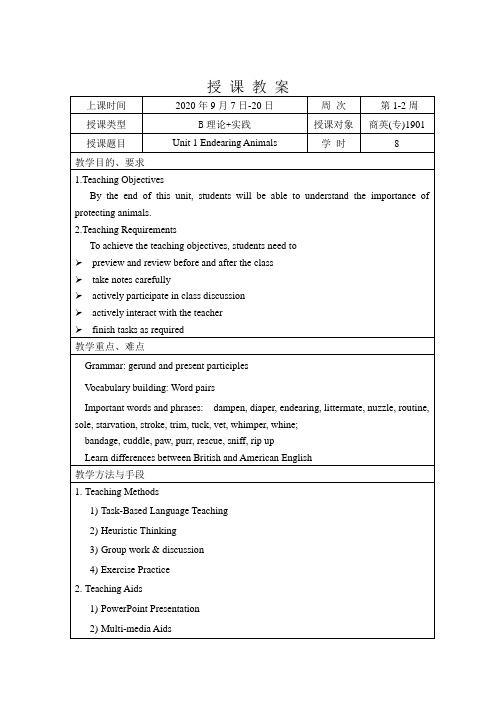
3Do young people and old people keep pets for same reasons?
Part3:Vocabulary
Student should complete task B on page 2 and task D on page 3 before class and teacher ask some students to give answers。
Part3: Careful Reading
First, listen to the tape para by para.
Second, a certain student read one para.
Third, a certain student translate some sentences which have different expression in Chinese.
actively interact with the teacher
finish tasks as required
教学重点、难点
Grammar: gerund and present participles
Vocabulary building: Word pairs
Important words and phrases:dampen, diaper, endearing, littermate, nuzzle, routine, sole, starvation, stroke, trim, tuck, vet, whimper, whine;
2)Heuristic Thinking
3)Group work & discussion
致用英语综合教程1_UNIT1_教案及课件
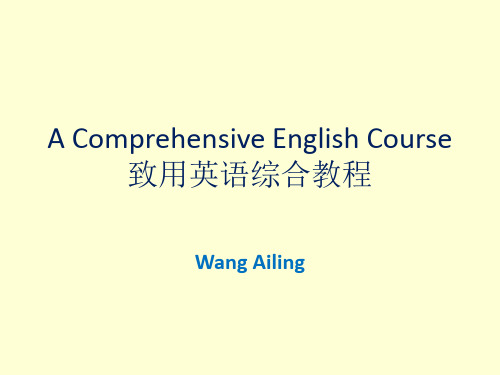
• What are Peter martin’s advices? • • • • • • • Listen and answer Advice1 : Advice 2: Advice 3: Advice 4: …… Are you puzzled with all these advices?
e.g. People tend to need less sleep as they
get older.
Plants tend to die in hot weather if you
don’t water them.
Warm-up Reading Language in use Project Learning to learn
T
Para. 3
3.
Find your own way.
Warm-up Reading Language in use Project Learning to learn
People tend to learn language in different ways. Some are fond of analyzing the language and need a rule for everything. Others are more intuitive; they prefer to gather examples and imitate them. Some need lots of repetition, while others hate repetition practice. In a classroom situation, the teacher cannot meet every student’s needs. Therefore, you cannot always rely on your teacher to provide you with a way that is specially designed for you. You need to experiment and discover what works best for you.
致用英语综合教程综合英语2教案综合英语2教案unit(I).doc

Period One – Around the TopicPeriod Length: 50 minutesGoals-Prepare to understand a modern short storyPurposes-To understand what a short story isStep 1: Vocabulary (15 minutes)-Work on the vocabulary about legend, tale and myth on Page 52 in groups-Discuss the similarities and differences of the three wordsStep 2: Short Story Introduction (35 minutes)-Discuss what short story is in groups and list main components of a short story -Discuss and list ideas of what a good short story is-Introduce short story and some master piecesKey points-All activities carried in EnglishHomeworkPeriod Two – Reading (1): Mr. JonesPeriod Length: 50 minutesGoals-Vocabulary and grammar-Discourse knowledgePurposes-Learn new words and expressions-Understand key grammar points-Understand related discourse knowledgeStep 1: Pre-reading Tasks (15 minutes)-Discuss briefly the words and the task on Page 54 in groups-Check briefly the preview results from studentsStep 2: Reading activity (Part One: 25 minutes)-Listen to the reading-Ask students to present new words and sentences in groups-Ask students to give feedbacks for the information presented-Give more explanations to the new words and sentences-Provide extra knowledge about new words-Guide more on sentences and grammarStep 3: Summarization (10 minutes)-Summarize the words and sentences-Summarize the text learntKey points-Instructions and tasks carried in English, Chinese is used only when necessaryHomework-Review the learnt sections-Preview the following parts and exercisesPeriod Length: 50 minutesGoals-Vocabulary and grammar-Discourse knowledgePurposes-Learn new words and expressions-Understand key grammar points-Understand related discourse knowledgeStep 1: Pre-reading Tasks (15 minutes)-Discuss briefly the previously learnt part for understanding-Check briefly the preview results from studentsStep 2: Reading activity (Part Two: 25 minutes)-Listen to the reading-Ask students to present new words and sentences in groups-Ask students to give feedbacks for the information presented-Give more explanations to the new words and sentences-Provide extra knowledge about new words-Guide more on sentences and grammar-Check the comprehension questions on Page 56Step 3: Summarization (10 minutes)-Summarize the words and sentences-Summarize the text learntKey points-Instructions and tasks carried in English, Chinese is used only when necessaryHomework-Review the learnt sections-Preview the following parts and exercisesPeriod Length: 50 minutesGoals-Enhance the vocabulary abilityPurposes-Learn detailed usage of certain words-Learn detailed usage of certain language structuresStep 1: Exercise A (15 minutes)-Work Vocabulary and Structure exercise A on Page 56 in groups -Check and compare answers in groups and negotiate them-Ask students to present their answers-Provide feedbacks for answersStep 2: Exercise B (15 minutes)-Work exercise B on Page 57 in groups-Check and compare answers in groups and negotiate them-Ask students to present their answers-Provide feedbacks for answersStep 3: Exercise C (20 minutes)-Work exercise C & D on Page 57 in groups-Check and compare answers in groups and negotiate them-Ask students to present their answers-Provide feedbacks for answersKey points-Instructions and activities be carried in EnglishHomework-Finish Writing Task on Page 58 and turn them in due next period -Prepare for the grammar and vocabulary exercisesPeriod Five – Language in UsePeriod Length: 50 minutesGoals-Grammar knowledge and vocabulary buildingPurposes-Narrative Tenses-Phrasal Verbs with off and outStep 1: Narrative Tenses (30 minutes)-Test grammar knowledge on Page 59 for checking grammar abilities-Work on exercises A, B & C on Pages 59 & 60 in groups-Ask students to present their answers and provide necessary explanations -Give supplementary information on those structures if necessaryStep 2: Phrasal Verbs with off and out (20 minutes)-Work on exercises A & B on Pages 28 in groups-Ask students to present their answers and explain Compound words-Give supplementary information on Compound words if necessaryKey points-Give instructions in English-Explain grammar knowledge in ChineseHomeworkPeriod Six – Extension: The Enchanted KnifePeriod Length: 50 minutesGoals-Extend reading abilitiesPurposes-Apply previously learnt vocabulary and cultural knowledge in reading-Develop reading abilities-Improve abilities on negotiation and discussionStep 1: Reading (20 minutes)-Ask students to read The Enchanted Knife on Page 30 in groups-Understand new words and sentences within the group by negotiating in English -Finish Vocabulary Check on Page 64Step 2: Discussion (30 minutes)-Discuss questions listed on Page 64-Ask each group to present their opinions for the questions in front-Give feedbacks and remarks for presentationsKey points-Inspect group discussions and give guidance to promote discussionsHomework-Review previously learnt materials-Prepare for the ProjectPeriod Length: 50 minutesGoals-Teamwork abilitiesPurposes-Apply previously learnt words and cultural knowledge into actual use-Develop teamwork abilitiesStep 1: A Make-up story (25 minutes)-Make up a strange story following the example of Mr. Jones with clue words and instructions on Page 62Step 2: An odd experience (25 minutes)-Work in groups to finish the story of An odd experience on Page 62-Ask each group to present their stories and provide remarksKey points-All preparations and negotiations be carried in English-Give guidance while students prepare the projectHomeworkPeriod Length: 50 minutesGoals-See abovePurposes-See aboveStep 1: Prepare for a surprise (25 minutes)-Share your stories with others and present them with pictures if possibleStep 2: Evaluate stories (25 minutes)-Give remarks to the presentations after the whole class have finished presenting stories-Group members should also talk about what they have learnt from this presentation project.Key points-Give instructions for presentationHomework-Revise writings according to the feedbacks and remarks received-Turn the revised copies before next periodPeriod Nine – Culture Tips: AthenaPeriod Length: 50 minutesGoals-Understand part of western culture from another perspectivePurposes-Help students to understand western culture-Help students to learn more cultural expressionsStep 1: Warm-up (15 minutes)-Read materials on Athena on Page 65-Help on any new words if necessaryStep 2: Open Discussion (35 minutes)-Ask students to talk more about western myths and tales if possible-Encourage students to pay more attention to the western culture while learning a languageKey points-All activities be carried in EnglishHomeworkPeriod Ten – Learning to Learn Period Length: 50 minutesGoalsPurposesStep 1Step 2Key pointsHomework。
致用英语综合教程综合英语2教案unit.doc
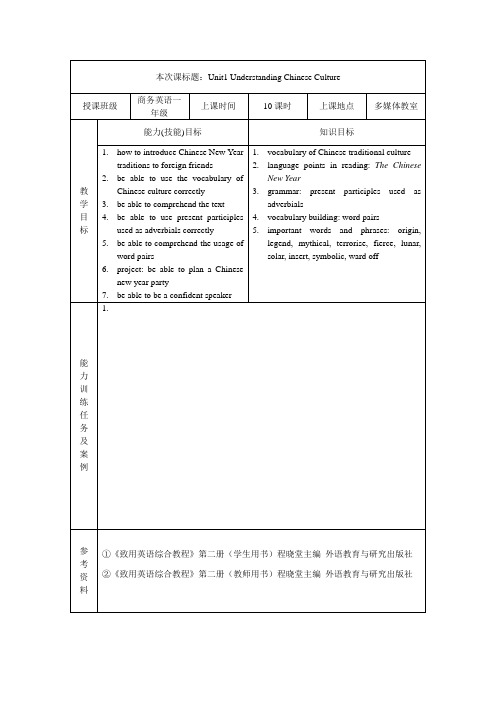
Section One Around the topicStep 1 Topic introduction:Many Chinese students find it very difficult to introduce Chinese culture to foreign friends.The biggest problem is that they don’t know how to express their understanding about Chinese culture or how to explain some typical concepts in Chinese culture. Chinese learners of English as a foreign language should not only study western cultures, but also deepen their understanding of Chinese culture, so that they can introduce it to the outside word.Step 2 Your ideasWork in groups or pairs and discuss the following questions1)Why is spring Festival so important for the Chinese people?2)What do you usually do during the Spring Festival3)Are there any special celebration activities in your hometown during Spring Festival?4)In what ways do you think the Spring Festival has Changed?How much do you know about the Chinese New Year?A.Which day in the 15-day celebration is for the sons-in-laws to pay a visit to theirparents-in-law?The third and fourth days.B. What is the fifth day called?Po Woo.C. How many kinds of traditional New Year food do you know?Dumplings, a whole fish, chicken, New Year cake…D. Do we use knives or scissors on New Year's Day?NO. They may cut off fortune.E. What fruit do we usually use as a decoration during the Spring Festival?Oranges and Tangerines. They are symbols for abundant happiness.Step 3 VocabularyThere are some special things about Spring Festival, which are difficult to translate into English. Here are some English words and expressions related to the Spring Festival. Try to get their meanings.Remind students that names of some typical Chinese things do not have exact equivalents in English. Ask them to guess the meaning of the English words and phrases related to theThe teacher can offer students a particular situation for students to practice in which students can give a brief talk with some of the words in the table above so that they can master a better usage of these words.Step 4 Listening and speakingAsk students to read the questions first. Then play the recording and encourage them to take notes while listening.1.Q: What are they talking about?A: They are talking about the Spring Festival.2.Q: How did Li Ming spend his holiday?A: Li Ming spent his holiday with his family in his hometown.3.Q: What is Susan curious about?A: Susan is curious about how Chinese people celebrating their Spring Festival.4.Q: What make the Spring Festival different from other holidays?A: Giving presents and staying with the family.5.Q: What do Chinese People do on the Eve of the Spring Festival according to the recording?A: In the past, all the members of a family would stay at home making dumplings together.Now many people enjoy watching TV. During the day, children wear their new clothes. The evening is usually spent playing games, talking, eating and drinking.Step 5 A quizDuring the Spring Festival, some things are believed to bring good luck for the new year, while other things might bring bad luck. Read the items in the table below and decide whether they bring good luck or bad luck. When you finish, compare your answers in pairs.This quiz is just for fun. Remind students that we should not be superstitious and the dos and don’ts during the Spring Festival are only parts of our traditions and customs. We should hold a right attitude towards them.Ask students to do the exercise first based on their own understanding and then compare their answers with their partners’. They may discuss them if necessary. When they finish, you may show and explain answers.Section Two ReadingThis section introduces the tradition of the Chinese New Year. By studying it, students will learn more about the legend of Nian and traditional Chinese New Year celebration activities. Most importantly, students will learn how to introduce the Chinese New Year to foreign friends.Step 1 Pre-reading tasksBefore you read, discuss the following questions in groups:1.Do you know why we call the Spring Festival “Nian”?2.Do you know why we Chinese celebrate the New Year at a different time from the Westernworld?Read the instruction as a class. Divide students into groups. Ask them to discuss the questions. Activate their prior knowledge of the Spring Festival and encourage them to share informationwith others. Pick some volunteers to answer these tow questions as representatives of their group. Step 2 Text illumination1)Ask several students to read the whole text in order to check whether they preview thetext and get a general understanding bout it or not beforehand.2)Ask students to summarize the text3)The teacher can put the comprehension check either before or after illuminating the textaccording to the needs of class and the students’ comprehension ability.4)Illuminate the text, during the process of which the teacher can encourage students tohighlight or underline the important parts when they read the text in detail. Try to explain that it can help students to grasp the important details and review important points Language points:1. legend n.story handed down from the past, especially one that may not be true 传奇,传说e.g. The legend of Robin Hood is well-known.2. mythical adj. existing only in an ancient story, imagined or invented 神话的,虚构的e.g. Qi Lin is a mythical Chinese creature which is similar to a unicorn.myth n. 神话e.g. ancient Greek myths3. terrorise v. to fill or overpower with terror, to terrify 使惊恐不安,恐吓e.g. The local gangs terrorised the neighborhood.4. fierce adj. violent and angry 凶猛的,凶狠的e.g. Swans are always fierce in defense of their young.The leopard looks fierce.5. lunar adj. determined or measured in reference to the moon 根据月亮决定或测定的e.g. The Chinese New Year falls on lunar January, 1st.6. solar adj. determined or measured in reference to the sun 根据太阳决定或测定的e.g. Solar energy is one kind of important energy nowadays.7. insert v. to put or set into, between, or among 插入,嵌入e.g. The editor inserted an advertisement in the newspaper.insert a key into a lock8. symbolic adj. representing a particular idea or quality 象征的,符号的e.g. The cross is symbolic of Christianity9. ward off to keep away (somebody/something that is dangerous or unpleasant) 挡开,避开e.g. He carried a gun to ward off possible attacks.Step 3 Post-reading exercises1.What is the significance of the following things during the Spring Festival?2.Discussion:Read the instruction as a class. Divide students into groups of four. Ask them to discuss these questions. Get feedback when they finish. Try to encourage them to express their opinions thoroughly in English.3.V ocabulary and structureThis part is about some vocabulary and structure exercises related to the text. Ask students to finish them independently beforehand. Check their answers in class. Try to encourage them to explain by themselves to check whether they fully understand the exercises or not. The teacher is supposed to give some explanations if necessary.A.Work out the meanings of the underlined words with the help of the context.B.Fill in the blanks with the words below. Change the form where necessary.plete each pair of the sentences with the correct form of the same verb, one as apresent participle (-ing) and the other as a past participle (-ed).4.WritingRead the instruction as a class. Leave the writing task as homework. Check their work next time.Write down your experience about the Spring Festival. The following questions may help you to come up with some ideas.1)How does your family prepare for the Spring Festival?2)What traditional activities does your family do to celebrate the Spring Festival?3)What special activity do you like most when you are celebrating the Spring Festival?Section Three language in use: present participles used as adverbialsStep 1 test your grammarThe aim of this practice is to make students aware of the present participles used as adverbials. Based on their study of the text, they may gain a deeper understanding by doing these exercises. Try to encourage students to explain by themselves through recalling and understanding of this grammatical phenomenon.Step 2 illumination and developmentBriefly explain the grammatical knowledge of participles. Then ask students to finish these exercises. Check their work when they finish.一、现在分词做状语(表原因,时间,条件,让步,行为方式,伴随状况)现在分词与主句的主语一致,且形成主谓关系,就是说现在分词的动作发出者是主句的主语。
致用英语综合教程综合英语2教案综合英语2教案unit(2).doc
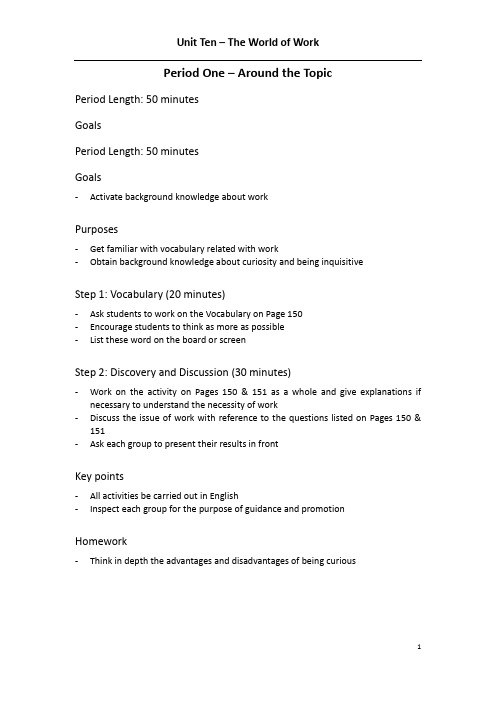
Period One – Around the TopicPeriod Length: 50 minutesGoalsPeriod Length: 50 minutesGoals-Activate background knowledge about workPurposes-Get familiar with vocabulary related with work-Obtain background knowledge about curiosity and being inquisitiveStep 1: Vocabulary (20 minutes)-Ask students to work on the Vocabulary on Page 150-Encourage students to think as more as possible-List these word on the board or screenStep 2: Discovery and Discussion (30 minutes)-Work on the activity on Pages 150 & 151 as a whole and give explanations if necessary to understand the necessity of work-Discuss the issue of work with reference to the questions listed on Pages 150 & 151-Ask each group to present their results in frontKey points-All activities be carried out in English-Inspect each group for the purpose of guidance and promotionHomework-Think in depth the advantages and disadvantages of being curiousPeriod Length: 50 minutesGoals-Vocabulary and grammar-Discourse knowledgePurposes-Learn new words and expressions-Understand key grammar points-Understand related discourse knowledgeStep 1: Pre-reading Tasks (15 minutes)-Discuss briefly the short passage on Page 152 in groups-Check briefly the preview results from studentsStep 2: Reading activity (Part One: 25 minutes)-Listen to the reading-Ask students to present new words and sentences in groups-Ask students to give feedbacks for the information presented-Give more explanations to the new words and sentences-Provide extra knowledge about new words-Guide more on sentences and grammarStep 3: Summarization (10 minutes)-Summarize the words and sentences-Summarize the text learntKey points-Instructions and tasks carried in English, Chinese is used only when necessaryHomework-Review the learnt sections-Preview the following parts and exercisesPeriod Length: 50 minutesGoals-Vocabulary and grammar-Discourse knowledgePurposes-Learn new words and expressions-Understand key grammar points-Understand related discourse knowledgeStep 1: Pre-reading Tasks (15 minutes)-Discuss briefly the previously learnt part for understanding-Check briefly the preview results from studentsStep 2: Reading activity (Part Two: 25 minutes)-Listen to the reading-Ask students to present new words and sentences in groups-Ask students to give feedbacks for the information presented-Give more explanations to the new words and sentences-Provide extra knowledge about new words-Guide more on sentences and grammar-Check the comprehension questions on Page 154Step 3: Summarization (10 minutes)-Summarize the words and sentences-Summarize the text learntKey points-Instructions and tasks carried in English, Chinese is used only when necessaryHomework-Review the learnt sections-Preview the following parts and exercisesPeriod Length: 50 minutesGoals-Enhance the vocabulary abilityPurposes-Learn detailed usage of certain words-Learn detailed usage of certain language structuresStep 1: Exercise A (15 minutes)-Work Vocabulary and Structure exercise A on Page 155 in groups -Check and compare answers in groups and negotiate them-Ask students to present their answers-Provide feedbacks for answersStep 2: Exercise B (15 minutes)-Work exercise B on Page 155 in groups-Check and compare answers in groups and negotiate them-Ask students to present their answers-Provide feedbacks for answersKey points-Instructions and activities be carried in EnglishHomework-Finish Writing Task on Page 156 and turn them in due next period -Prepare for the grammar and vocabulary exercisesPeriod Five – Language in UsePeriod Length: 50 minutesGoals-Grammar knowledge and vocabulary buildingPurposes-Present Simple and Present Continuous-Phrasal VerbsStep 1: Present Simple and Present Continuous (30 minutes)-Test grammar knowledge on Page 157 for checking grammar abilities-Work on exercises A, B & C on Pages 157 & 158 in groups-Ask students to present their answers and provide necessary explanations -Give supplementary information on those structures if necessaryStep 2: Phrasal Verbs: Liberal or Idiomatic? (20 minutes)-Work on exercises A & B on Pages 159 in groups-Ask students to present their answers and explain phrasal verbs-Give supplementary information on phrasal verbs if necessaryKey points-Give instructions in English-Explain grammar knowledge in ChineseHomeworkPeriod Six – Extension: Do jobs change people? Period Length: 50 minutesGoals-Extend reading abilitiesPurposes-Apply previously learnt vocabulary and cultural knowledge in reading-Develop reading abilities-Improve abilities on negotiation and discussionStep 1: Reading (20 minutes)-Ask students to read Do Jobs Change People? on Page 162 in groups-Understand new words and sentences within the group by negotiating in English -Finish Vocabulary Check on Page 163Step 2: Discussion (30 minutes)-Discuss the job related topics in class-Ask each group to present their opinions for the questions in front-Give feedbacks and remarks for presentationsKey points-Inspect group discussions and give guidance to promote discussionsHomework-Review previously learnt materials-Prepare for the ProjectPeriod Length: 50 minutesGoals-Teamwork abilitiesPurposes-Apply previously learnt words and cultural knowledge into actual use-Develop teamwork abilitiesStep 1: Search for a Job Vacancy (25 minutes)-Work in groups and decide which role you would like: a job hunter or an interviewer? With reference to Page 160.-Read the above help-wanted ad. What qualities are needed for a good manager?Step 2: Vocabulary (25 minutes)-Ask students to work in pairs or groups to work on the vocabulary about jobs-Write down the questions you should ask the job hunter or interviewer.Key points-All preparations and negotiations be carried in English-Give guidance while students prepare the projectHomeworkPeriod Length: 50 minutesGoals-See abovePurposes-See aboveStep 1: Act out a job Interview (25 minutes)-Find a partner, either a job applicant or an interviewer and act out an interview.Be polite and friendly. You should at least interview or being interviewed once. .Step 2: The Best Person for the Job (25 minutes)-Students who have conducted interviews report to the class. First tell the class which questions you asked and then state clearly the reasons why you think you have chosen the right applicant.-Give remarks to the presentations-Group members should also talk about what they have learnt from this project.Key points-Give instructions for discussion and presentationHomework-Revise writings according to the feedbacks and remarks received-Turn the revised copies before next periodPeriod Nine – Culture Tips: What Drives US EmployeeSatisfactionPeriod Length: 50 minutesGoals-Understand part of western culture from another perspectivePurposes-Help students to understand western culture-Help students to learn more cultural expressionsStep 1: Warm-up (15 minutes)-Read materials on What Drives US Employee Satisfaction on Page 164-Help on any new words if necessaryStep 2: Open Discussion (35 minutes)-Ask students to offer more stories related to the topic-Encourage students to pay more attention to the situations that may occur in the job situations in the future.Key points-All activities be carried in EnglishHomeworkPeriod Ten – Learning to Learn Period Length: 50 minutesGoalsPurposesStep 1Step 2Key pointsHomework。
新编实用英语综合教程1-2教案
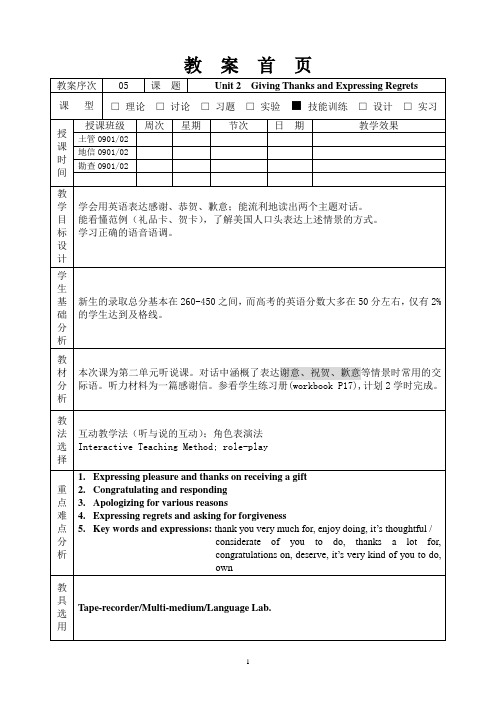
v. n. adj. adj.
Ido appreciateyour kindness.
9. It’s a pity that… = That’s too bad.
10.treatv.招待
11.Ido apologizefor this.
Donna: Yeah, I have learned a lesson. Andy, it was very thoughtful of you to send methe get-well cardyesterday.
Andy: Well, I just hope you can recover soon.
主板书设计
Unit Two
SectionⅠ& SectionⅡ
Language Points:
1.rightadj. /n.have a right to do sth.
2.look forward to sth. /doing sth.
3. like + to do
doing
panyn.陪同,陪伴;公司
key
2.Listento the tape for the first time without looking at the book.
3.Play the tape with a pause after each sentence for the second time
and ask the students to take notes of the key words.
Donna: Thank you. And I’d also like to thank you for these beautiful flowers.
致用英语综合教程综合英语2教案综合英语2单元设计unit
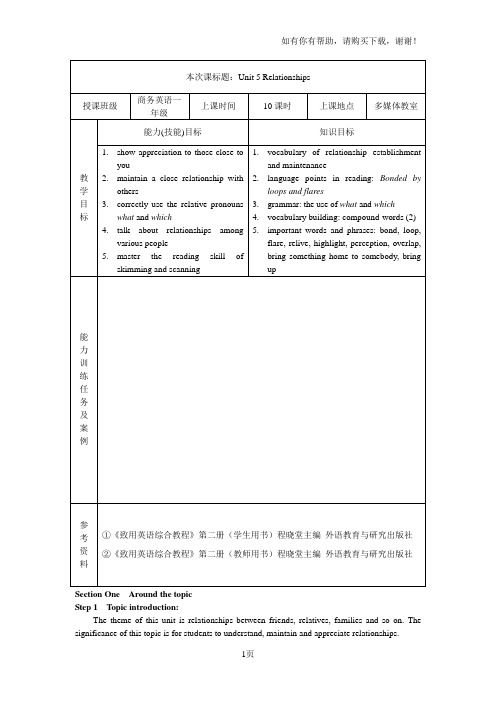
Section One Around the topicStep 1 Topic introduction:The theme of this unit is relationships between friends, relatives, families and so on. The significance of this topic is for students to understand, maintain and appreciate relationships.Step 2 Your ideas1.Listen to the song. Fill the blanks in the lyrics while listening.I believe I can loveYou give me your loving careI believe in what we areI don’t know where I would beWithout you staying with meSometimes, I’m lost in miseryYou will take me all the wayI’m not afraidOh, you and mehand in hand to everywhereAmazing be my friend, oh friendWe are forever friendsOh babyYou give me all the love I needYou are the only onePlay the song twice constantly and then encourage students to tell the answer by themselves. Step 3 vocabularyA.Work in pairs and think of as many English words as possible that havemeanings similar to friendly and unfriendly. Compare your list with anotherpairThis is a pair-work task. Ask students to brainstorm as many related words as possible.Then ask them to exchange opinions with other pairs. You may let them read out thewords they have got in front of the class.B.The underlined adjectives in the sentences below are all about friendliness.Read them and work out the meanings.Ask students to read these sentences carefully and discuss their meanings in pairs. Havethem explain the meanings in English.Answers:Friendly: acting or ready to act as a friendSociable: fond of making friends with people and enjoying being with othersAmiable: having a pleasant and friendly nature; good temperedIntimate: close in relationshipClose: near in relationship, friendshipWarm: friendly in a pleasant wayStep 4 discussionPut the class into small groups. Each group selects one student to note down the opinions of each speaker. After the discussion, you may collect their ideas by having some students give a report. This can be really interesting when show diverse opinions.1). In your opinion, what is a friend? What does friendship mean to you? What do youthink are the most important factors that can keep a long-lasting close relationship with your friends?2). What about with your family members and relatives?3). How can we make our close relationships last long?Step 5 listening and speakingA: Do you have family members, relatives or friends who live in a faraway place? What do you do to keep in touch with them? Do you do the following?●phone them●write letters to them●send them recorded cassettes●send them postcards●have flowers or other gifts delivered to them●e-mail them●send them text messages●visit them during holidays●chat with them onlineB: listening: John lives in Manchester. His sister, Mary, is studying French in Paris. She’s been there for five weeks. He wants to visit her in Paris and he wrote to her about it through an e-mail. He’s just received a message on the answer phone from her.This activity involves skills of both speaking and listening. Use the questions in task A to start a talk among students. The items listed in the text can give students some topics for continuing their talk.After the activity in task A, move on to the listening section. At the same time, ask students to pay attention to decide whether they are true or false. Have a class feedback when they finish. Section 2 Reading: Bonded by loops and flaresThe text Bonded by loops and flares is taken from the newspaper International Herald Tribune, written by David Brooks. Students may find the ideas expressed in this article quite new. Ask students to read the text carefully and have them do exercises individually. When they finish, ask them to exchange and discuss the answers with their partners.Step 1 Pre-reading questionsRead these questions and then put students into small groups for a brief discussion. Give them a few minutes to prepare. Ask one or two groups to tell the whole class their conclusions and reasons when they finish.Do you think people’s perception and thinking are greatly influenced by others? If so, by whom are people most probably influenced? Discuss these questions in groups.Step 2 Text illumination1) Ask several students to read the whole text in order to check whether they preview the textand get a general understanding about it or not beforehand.2) Ask students to summarize the text3) The teacher can put the comprehension check either before or after illuminating the textaccording to the needs of class and the students’ comprehension ability.4) Illuminate the text, during the process of which the teacher can encourage students tohighlight or underline the important parts when they read the text in detail. Try to explain that it can help students to grasp the important details and review important points Language points:1. loop n. a shape like a curve or circle made by a line curving back towards itself 环形,圈状。
致用英语综合教程1_UNIT1_教案及课件
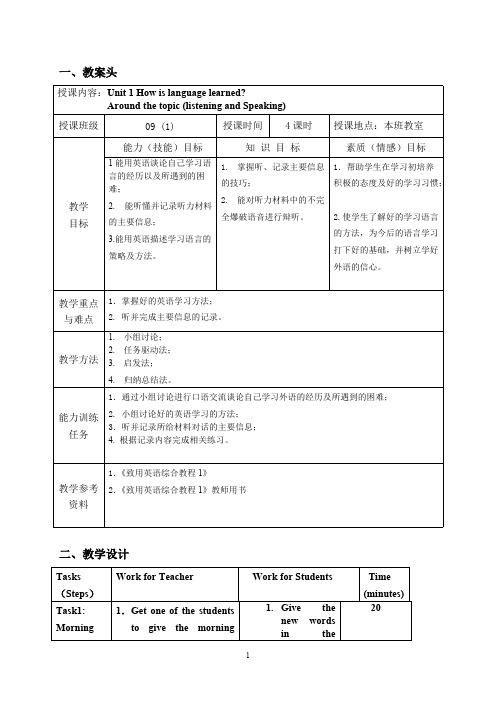
一、教案头授课内容:Unit 1 How is language learned?Around the topic (listening and Speaking)授课班级09 (1)授课时间4课时授课地点:本班教室能力(技能)目标知识目标素质(情感)目标教学目标1能用英语谈论自己学习语言的经历以及所遇到的困难;2.能听懂并记录听力材料的主要信息;3.能用英语描述学习语言的策略及方法。
1. 掌握听、记录主要信息的技巧;2. 能对听力材料中的不完全爆破语音进行辩听。
1.帮助学生在学习初培养积极的态度及好的学习习惯;2.使学生了解好的学习语言的方法,为今后的语言学习打下好的基础,并树立学好外语的信心。
教学重点与难点1.掌握好的英语学习方法;2.听并完成主要信息的记录。
教学方法1.小组讨论;2.任务驱动法;3.启发法;4. 归纳总结法。
能力训练任务1.通过小组讨论进行口语交流谈论自己学习外语的经历及所遇到的困难;2. 小组讨论好的英语学习的方法;3.听并记录所给材料对话的主要信息;4. 根据记录内容完成相关练习。
教学参考资料1.《致用英语综合教程1》2.《致用英语综合教程1》教师用书二、教学设计Tasks (Steps)Work for Teacher Work for Students Time(minutes)Task1: Morning 1.Get one of the studentsto give the morning1.Give thenew wordsin the20report report to the wholeclass;2.Talk about the topic orcomment on their jobs.report;2.Report tothe wholeclass;3.Ask andanswer thequestions.Task 2: Discussion 3.Talk about theexperience of learningEnglish and thedifficulties that evermet while learning;4.Divide the class intosmall groups and getstudents to share theirown experiences oflearning English;5.Invite some to sharewith the whole class.1.Talk about theexperiences oflearning Englishin English;2.Some volunteersshare with theclass.20Task 3: pre-listening activities 1.Get the individual tofinish a quiz.2.Read the scoringmethods andexplanations to theclass.3.Get the Ss to discuss onthe topic: What makesa good Englishlearner ?4.Do class feedback andwrite down the Ss’opinions on the Bb.1.Finish the quiz;2.Count the pointsthey’ve got andfigure out howgood languagelearners they are.3.Discuss in groupsof 4 and preparea presentation infront of class.40Task 4: Discussion 1.Have the students workin groups to discuss theways to learn Englishwell and let them write1.Work in groups todiscuss the waysto learn Englishwell and let them35down;2.Make each groupswrite the ways on theBb;3.Get them to discusswhich ways are the bestand let them talk abouttheir opinions.write down;2.Discuss the bestways to help themto learn English.Task 5: while-listening activities 1. Tell students what theyare going to listen , makethem get ready;2. Ask students to read thequestions first beforelistening;3. Play the recording andencourage them to takenotes while listening;4. Guide them to listen tothe recording three times;5. Get students to checktheir answers..1. Listen for the 1sttime and try to pickout the sameinformation fromthe listeningmaterial as thesuggestions listed onthe Bb.2. Listen for the 2ndtime to note downthe advice. 3. Listenfor the 3rd time tocheck the answers.4. Compare theanswers in pairs.40Task 6 : post-listening activities 1. Play the recording andget the Ss to repeat.2. Get the Ss to discuss ingroups of 4 on Mr.Martin’s opinions.1. Listen and repeat tocorrect the diction.2. Discuss in groups of 4.20Summary Summarize what studentshave learned in this lesson,point out what they shouldmaster.4Homework Pre-learn the words appeared in the word list.1三、教学后记1. 讲课之前让学生用英语简单的介绍一下自己,看看学生的实际水平并相互熟悉,使课堂气氛轻松;2. 在听力练习开始之前,先让学生简单地讨论一下自己的英语学习经历并谈论自己在学习中所遇到的难题以及解决办法,有助于学生更好地抓住听力材料中的关键内容。
- 1、下载文档前请自行甄别文档内容的完整性,平台不提供额外的编辑、内容补充、找答案等附加服务。
- 2、"仅部分预览"的文档,不可在线预览部分如存在完整性等问题,可反馈申请退款(可完整预览的文档不适用该条件!)。
- 3、如文档侵犯您的权益,请联系客服反馈,我们会尽快为您处理(人工客服工作时间:9:00-18:30)。
备注:
1.页面大小可自行添减,每上一次课写一份上述格式教案,一次课一般2个学时。
2.近三年参加工作的青年教师必须写详案。
3.手写教案格式参照表格内容。
备注:
1.页面大小可自行添减,每上一次课写一份上述格式教案,一次课一般2个学时。
2.近三年参加工作的青年教师必须写详案。
3.手写教案格式参照表格内容。
1.页面大小可自行添减,每上一次课写一份上述格式教案,一次课一般2个学时。
2.近三年参加工作的青年教师必须写详案。
3.手写教案格式参照表格内容。
备注:
1.页面大小可自行添减,每上一次课写一份上述格式教案,一次课一般2个学时。
2.近三年参加工作的青年教师必须写详案。
3.手写教案格式参照表格内容。
备注:
1.页面大小可自行添减,每上一次课写一份上述格式教案,一次课一般2个学时。
2.近三年参加工作的青年教师必须写详案。
3.手写教案格式参照表格内容。
职业技术学院教案
备注:
1.页面大小可自行添减,每上一次课写一份上述格式教案,一次课一般2个学时。
2.近三年参加工作的青年教师必须写详案。
3.手写教案格式参照表格内容。
职业技术学院教案
备注:
1.页面大小可自行添减,每上一次课写一份上述格式教案,一次课一般2个学时。
2.近三年参加工作的青年教师必须写详案。
3.手写教案格式参照表格内容。
职业技术学院教案
备注:
1.页面大小可自行添减,每上一次课写一份上述格式教案,一次课一般2个学时。
2.近三年参加工作的青年教师必须写详案。
3.手写教案格式参照表格内容。
职业技术学院教案
备注:
1.页面大小可自行添减,每上一次课写一份上述格式教案,一次课一般2个学时。
2.近三年参加工作的青年教师必须写详案。
3.手写教案格式参照表格内容。
职业技术学院教案
备注:
1.页面大小可自行添减,每上一次课写一份上述格式教案,一次课一般2个学时。
2.近三年参加工作的青年教师必须写详案。
3.手写教案格式参照表格内容。
